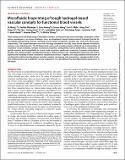| dc.contributor.author | Wang, Di | |
| dc.contributor.author | Maharjan, Sushila | |
| dc.contributor.author | Kuang, Xiao | |
| dc.contributor.author | Wang, Zixuan | |
| dc.contributor.author | Mille, Luis S | |
| dc.contributor.author | Tao, Ming | |
| dc.contributor.author | Yu, Peng | |
| dc.contributor.author | Cao, Xia | |
| dc.contributor.author | Lian, Liming | |
| dc.contributor.author | Lv, Li | |
| dc.contributor.author | He, Jacqueline Jialu | |
| dc.contributor.author | Tang, Guosheng | |
| dc.contributor.author | Yuk, Hyunwoo | |
| dc.contributor.author | Ozaki, C Keith | |
| dc.contributor.author | Zhao, Xuanhe | |
| dc.contributor.author | Zhang, Yu Shrike | |
| dc.date.accessioned | 2023-12-06T15:43:08Z | |
| dc.date.available | 2023-12-06T15:43:08Z | |
| dc.date.issued | 2022-10-28 | |
| dc.identifier.uri | https://hdl.handle.net/1721.1/153127 | |
| dc.description.abstract | Three-dimensional (3D) bioprinting of vascular tissues that are mechanically and functionally comparable to their native counterparts is an unmet challenge. Here, we developed a tough double-network hydrogel (bio)ink for microfluidic (bio)printing of mono- and dual-layered hollow conduits to recreate vein- and artery-like tissues, respectively. The tough hydrogel consisted of energy-dissipative ionically cross-linked alginate and elastic enzyme–cross-linked gelatin. The 3D bioprinted venous and arterial conduits exhibited key functionalities of respective vessels including relevant mechanical properties, perfusability, barrier performance, expressions of specific markers, and susceptibility to severe acute respiratory syndrome coronavirus 2 pseudo-viral infection. Notably, the arterial conduits revealed physiological vasoconstriction and vasodilatation responses. We further explored the feasibility of these conduits for vascular anastomosis. Together, our study presents biofabrication of mechanically and functionally relevant vascular conduits, showcasing their potentials as vascular models for disease studies in vitro and as grafts for vascular surgeries in vivo, possibly serving broad biomedical applications in the future. | en_US |
| dc.language.iso | en | |
| dc.publisher | American Association for the Advancement of Science (AAAS) | en_US |
| dc.relation.isversionof | 10.1126/sciadv.abq6900 | en_US |
| dc.rights | Creative Commons Attribution-Noncommercial | en_US |
| dc.rights.uri | http://creativecommons.org/licenses/by-nc/4.0/ | en_US |
| dc.source | AAAS | en_US |
| dc.title | Microfluidic bioprinting of tough hydrogel-based vascular conduits for functional blood vessels | en_US |
| dc.type | Article | en_US |
| dc.identifier.citation | Wang, Di, Maharjan, Sushila, Kuang, Xiao, Wang, Zixuan, Mille, Luis S et al. 2022. "Microfluidic bioprinting of tough hydrogel-based vascular conduits for functional blood vessels." Science Advances, 8 (43). | |
| dc.contributor.department | Massachusetts Institute of Technology. Department of Mechanical Engineering | en_US |
| dc.relation.journal | Science Advances | en_US |
| dc.eprint.version | Final published version | en_US |
| dc.type.uri | http://purl.org/eprint/type/JournalArticle | en_US |
| eprint.status | http://purl.org/eprint/status/PeerReviewed | en_US |
| dc.date.updated | 2023-12-06T15:39:55Z | |
| dspace.orderedauthors | Wang, D; Maharjan, S; Kuang, X; Wang, Z; Mille, LS; Tao, M; Yu, P; Cao, X; Lian, L; Lv, L; He, JJ; Tang, G; Yuk, H; Ozaki, CK; Zhao, X; Zhang, YS | en_US |
| dspace.date.submission | 2023-12-06T15:40:03Z | |
| mit.journal.volume | 8 | en_US |
| mit.journal.issue | 43 | en_US |
| mit.license | PUBLISHER_CC | |
| mit.metadata.status | Authority Work and Publication Information Needed | en_US |
